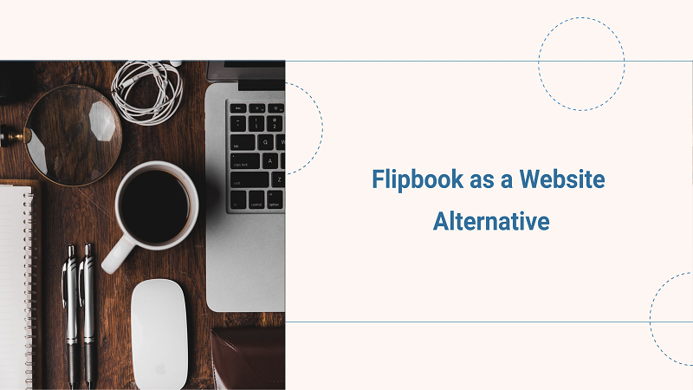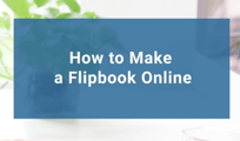As a small business owner, you probably keep hearing that a strong digital presence is crucial for building your brand and attracting new clients. This is true, of course. Not only do people search for products and services online, but they also base their opinion about a brand on its website and social media accounts.
The era of free website builders and landing page builders makes setting up a website much easier. But it is still time-consuming and requires a diverse skill set or an entire team of professionals to do everything right. And what’s more important—not every business needs a complex website. If you aren’t a SaaS platform or a store of the Amazon level (and it’s probably safe to assume you’re not, otherwise you wouldn’t be reading this), you don’t have to spend thousands of dollars and hundreds of hours on web development. Sometimes, a simple portfolio or an online catalog with a sign-up form is enough to showcase your products and generate leads.
If that’s what you are looking for, let us introduce you to a simple and creative website builder alternative: interactive documents. In this article, we’ll discuss what a flipbook is, what makes it (in some cases) a great substitute for a traditional website, and how to create your own flipbooks with FlippingBook.
What’s an Online Flipbook?
It’s a digital format for presenting content as online publications with a page flip effect, or flipbooks. A flipbook is created with the HTML5 technology that makes it as powerful and flexible as any modern website, and allows you to view it in any browser and on any screen.
FlippingBook lets you create interactive flipbooks from ordinary PDFs. Simply upload a PDF to the platform, and it will be converted into a powerful interactive document. This allows you to turn any PDF to a website in just a few minutes.
Flip through this gorgeous flipbook example to see the format in action. With all key elements—the main page, examples, ‘About us’, and Contacts—in place, it’s an easy way to turn a PDF to a landing page or even a simple website.
Create yours
💡 Grab a free website Canva template we've created specially for you and publish it to FlippingBook via a handy integration.
What Content Works Well as a Flipbook?
Flipbooks are great for presenting all kinds of information that you would traditionally print out: portfolios, catalogs, lookbooks, guides, menus, and more. And the best part is you need absolutely no skills to create a flipbook—only a PDF and an Internet connection.
What Makes a Flipbook a Great Website Alternative?
A flipbook can be perfect as a website or landing page alternative, and when you don’t have months or even days to get information out there. With tools like Canva and FlippingBook, you can quickly put together your content in the PDF format and publish it online as a link-based flipbook.
| Feature/Factor | PDFs | Landing pages/Websites | Flipbooks |
| Hosting | Downloadable file, no hosting needed (but limited access) | Needs hosting & domain | Hosted online, on a custom domain (optional) |
| SEO Optimization | Not SEO-friendly (search engines can’t crawl well) | Fully SEO-optimized | SEO-optimized |
| Mobile Experience | Often clunky, pinch-to-zoom | Responsive design possible | Responsive, interactive, swipeable |
| Ease of Setup | Simple to prepare and send via email | Not easy, requires design and build | Quick conversion from PDF, minimal setup |
| Coding Required | None | Usually yes (or no-code builder) | None |
| Design & Branding | Static, limited interactivity | Fully customizable | Branded or white-label, interactive |
| Lead Generation | Requires external forms | Forms, CTAs, integrations | Embedded forms, CTAs, integrations |
| Shareability | Limited, attachment-based | Easy (links and social sharing) | Easy (links, socials, website embeds) |
| Updating | Requires resending | Easy when self-admined | Updates go live instantly, the link stays the same |
As you can see, flipbooks offer almost the same features as websites and landing pages, but are much easier to set up and update. Now, let’s take a closer look at some of the benefits of flipbooks over websites.
#1 You don’t need to worry about web hosting
When you create a flipbook with FlippingBook, it instantly uploads your content to the cloud and provides you with a direct link you can share. There’s no need to set up and register domains and build everything from scratch. Thanks to the built-in document hosting service, the moment you’ve created your flipbook, it’s ready to be shared with the world. This is a huge advantage if you are pressed for time and don’t have a few weeks to set up and fine-tune your website.
As a bonus, you don’t need to go through tiresome testing before publishing your content. And if you need any help, the FlippingBook support is always there to lend a hand.
#2 Branding and Design Are Easy
Unlike PDFs that have a dull grey background, flipbooks have a clean and professional design that complements any content. So the format is perfect for design rookies! And if you wish to make your content instantly recognizable, you can do so in a couple of clicks by adding your logo, favicon, and brand colors. This way, when people jump to your flipbook from a social media post or a banner ad, they will know you at first glance.
#3 Your content is SEO-friendly
Getting your website to the top of search results is a constant struggle. The idea may seem simple on the surface—just write the content that is clear and relevant to your target audience. But with Google constantly changing algorithms and guidelines, prioritizing mobile websites, punishing and encouraging certain practices, getting anywhere near the first page of Google takes lots of effort and expertise.
When you use our tool as a website alternative, FlippingBook does part of the SEO job for you. It takes your PDF content and optimizes it for search engines: it sets the metatags and provides crawlers with clear, well-structured content for easy and fast indexing. Here’s our case study and a video guide on flipbooks and SEO if you wish to learn more.
#4 You can sell products with flipbooks
You can sell your PDF flipbooks directly as digital products, such as ebooks or guides. Or use them as showcases for your products or services, and add links to buy from external platforms—for example, your Etsy store.
Another option to collect orders with your flipbook is by adding a fillable form. You can create one in Typeform or even Google Forms, and then embed it as a clickable button that opens the form in a pop-up. The whole process can take less than 15 minutes.
#5 You can get interactive content without coding
Choosing an alternative for a website builder, you should consider interactivity, too, as it is an essential part of any digital experience.. With flipbooks, you can easily benefit from it without touching a single line of code.
FlippingBook offers an intuitive drag-and-drop editor that lets you add videos, GIFs, pop-up image galleries, forms and quizzes, and outbound links right to the pages of your flipbook. It only takes a couple of clicks, and your visitors can enjoy all sorts of engaging interactive content.
#6 Flipbooks have built-in lead generation
The purpose of any website is to bring in leads and convert them into buyers. While flipbooks created with FlippingBook don’t have a ready-to-go tool for online sales, the format still works nicely if you are looking to collect prospects and take orders.
Thanks to a customizable sign-up form you can place on any page of your flipbook, you can achieve two goals:
- Gate your content, leaving a few first pages as a preview. This way, you will turn your ebook or a catalog into a lead magnet.
- Place the lead collection form at the end of the flipbook and turn it into a “Contact us” form to give your visitors an option to reach out to you.
💡According to our research, 90% of emails submitted through the FlippingBook Online lead capture form are valid. Thus, you get high-quality leads right from your flipbook!
#7 The FlippingBook website easily integrates with your favorite apps
Some website builders strive to be one-stop shops, providing everything from design to payment management to custom mobile app development. But the truth is, you get the best results when you combine a few of the most effective tools and build the perfect toolkit, tailored to your needs.
Thanks to integrations via Zapier, an online automation solution that lets you connect different apps, you can easily add flipbooks to your workflow. You can use integrations to add the leads you’ve collected to your CRM or a digital marketing platform, or to create new flipbooks automatically. Read our blog post to learn how you can simplify your sales and marketing tasks with FlippingBook and Zapier integration.
#8 You get content analytics right on the FlippingBook platform
Tracking viewers’ interactions with your website is a must. It gives you in-depth insights into your audience and helps you make informed marketing decisions.
As with any other website, you can connect your flipbook with a Google Analytics account and gather all the statistics there. But you can also track all the key metrics—views, clicks, session durations, and more—right in FlippingBook.
#9 A flipbook can be a budget-friendly website solution
Depending on the scope of your project and whether you handle everything yourself or hire a professional designer and developer, setting up a simple website can cost you anywhere between $50 and a $1,000 upfront, plus $20-$50 monthly for maintenance.
By comparison, hosting a 10-page flipbook with a platform like FlippingBook also costs about $20-50 monthly, but with no upfront expenses. It can save you hundreds of dollars in the long run since you can update the content yourself in just a few minutes—without needing outside help.
Bonus: How to Create a PDF?
Creating a website alternative with FlippingBook is easy once you get a PDF with the content you need. However, crafting the PDF itself may seem difficult if you’ve never done it before.
Fret not! You don’t have to be an Adobe Acrobat guru to create a beautiful PDF document. If you’re wondering where to start, try Canva. It’s an easy-to-use design tool that lets you create different types of digital content, PDFs included. You can create a PDF from scratch, or you can use one of our free templates if you need inspiration and help.
💡 Bonus Tip
For the best results, go for standard layout templates in Canva instead of website templates. Presentations, brochures, or catalogs would be good options. This will give you a neat-looking flipbook with minimum effort.
Flipbook as a Website Alternative FAQ
1. Can I launch a landing page without having a website?
Yes. There are dedicated landing page builders and platforms that let you design a standalone landing page. However, an easier way to put your content online is to convert it into an interactive flipbook—especially if you already have a PDF.
2. Can I turn a PDF into a website or landing page?
Yes. You can turn a PDF into an interactive piece of content hosted online, just like a regular website. Interactive documents, or flipbooks, support lead generation, provide engagement analytics, and help optimize PDF content for SEO—making them a strong alternative to websites and landing pages.
3. How do I create a landing page from a PDF?
The easiest way to make a landing page out of a PDF is to convert it into a flipbook. This allows you to publish your content online in a visually appealing, shareable format. Depending on your goals, you can also add lead capture or contact forms to your flipbook.
4. What’s the fastest way to publish a PDF as a website alternative?
You can quickly publish a PDF as a flipbook to present it online. It usually takes 2–10 minutes to upload a PDF to a flipbook platform and generate a shareable link for your audience—via messaging apps, social media, or even a QR code.
5. Do I need coding to create a flipbook website?
No, modern flipbook platforms let you create a flipbook-based website in just a few clicks. Simply upload your PDF into a tool like FlippingBook, and the platform will do the rest.
Wrap-up
Creating a digital presence is vital, but building a website can be time-consuming and complicated. If you are not looking to open an online shop, but just need a simple and creative way to present your content, a flipbook is a great way to do this. Ready to try? Check out our free 14-day trial and create your first flipbook today.
Create yours





